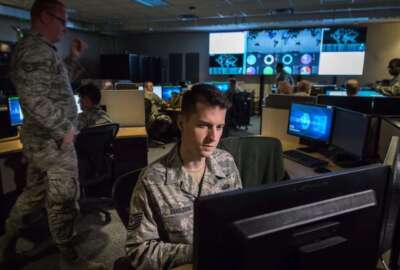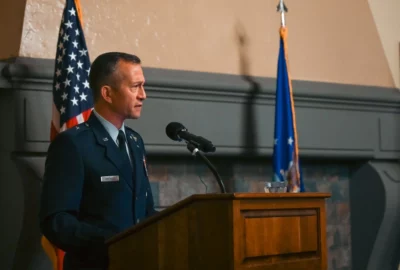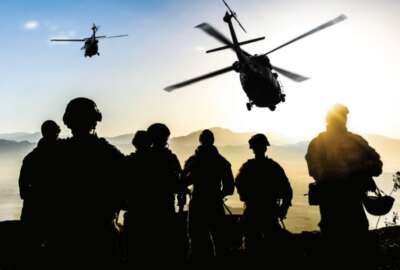First cohort of Air Force IT, cyber warrant officers to graduate in December
The first group of Air Force warrant officers in cyber and IT career fields will arrive at their assignments by January 2025.
The Air Force Warrant Officer Training School, activated in June, will welcome the inaugural class of about 30 candidates for an eight-week course in October. Graduates will arrive at their assignments by January 2025 — a significant milestone as the service reintroduces warrant officers into its ranks for the first time in six decades.
The second cohort of about 30 candidates will go through training in January 2025, and the third group is set to start in March.
The service announced its plans to bring back warrant officers within the cyber and information technology professions earlier this year as part of its sweeping set of efforts to reshape the service’s force structure.
Competition for the 78 warrant officer slots turned out to be fierce — the service received over 400 applicants when it opened the application process for the program in May.
Active-duty Airmen and members of the Air National Guard and Reserve who applied to become warrant officers come from diverse career fields, including intelligence analysis, cryptologic language analysis, cyber defense and cyber warfare, health services management and military training instructors.
Lt. Gen. Leah G. Lauderback, the Air Force deputy chief of staff for intelligence, surveillance, reconnaissance and cyber effects operations, said the selection board will make adjustments and provide guidance for those who were not selected or unable to apply this year.
“We’ll do another board next year. We’re learning as we go along. This next board that we have some time next year — late spring or summer perhaps. But we will have some of those lessons out for you if you were not actually selected or you weren’t able to put your package in for some reason,” Lauderback said during the Department of the Air Force Information Technology and Cyberpower event on Monday.
The service is still determining the number of warrant officers it needs, initially targeting around 320 positions, but ongoing analysis suggests the number could grow to about 350 warrant officers.
“As you do any analysis, you find out that we need to go back because that was just a beginning number. The team right now is going back to that analysis and determining if we have the need for more than 320ish warrant officers in the Air Force. I actually don’t know yet, but I do think that the number 320 will grow. In order for a career field to be sustainable you need about 350,” Lauderback said.
“[Manpower, Personnel and Training], right from the start, has told us we’ve got to work towards 350 in order to do that right. I know that I heard in the beginning, ‘This won’t be sustainable. It won’t work.’ It is going to work. And we absolutely have a need for our technical leaders that we want to make from these warrant officers.”
As part of the integration process, the Air Force will also conduct roadshows to educate personnel about the warrant officer rank, which has been absent from the service since 1959. These sessions will address how enlisted members should interact with warrant officers and the roles warrant officers will play alongside other ranks.
“What’s it like for an enlisted member when they meet with a warrant officer? Do they salute them or not? When the MPF helps out a warrant officer, and they’ve never seen a warrant officer, they’ve never seen this rank before. What do they do? These are the types of questions that we haven’t worked with in many years without having the warrant officers here,” Lauderback said.
“We need the wing commanders, the squadron commanders, etc., those folks that are in the workforces with our warrant officers to understand here’s a role for our enlisted members, here’s a role for our senior enlisted members, here’s a role for our warrant officers and here’s the role for our officers. So we’re working on all of that, and then the messaging to the workforce, so that they understand when you bring in a warrant officer to the base, he or she shouldn’t just be a unicorn, he or she is an integral part of the workforce and has a job to do.”
Lauderback said the Air Force is also looking to expand its pool of warrant officers by reaching out to those who left the service to join the Army as warrant officers, as well as tapping into the civilian workforce.
“I’m also really looking forward to stealing back some of the warrant officers in the Army. Airmen who went into the Army to become warrant officers — I’d like them to come home. We’re going to start with inter-service transfers, and then, of course, we want to be able to bring civilians in who don’t have an affiliation with the military. That is part of what we would like to get to in the next board; we just don’t have the details all worked out yet,” Lauderback said.
Specialized career tracks for officers
The service is also expanding its specialized career tracks for officers, a program that allows tech professionals to focus exclusively on their specialty rather than pursue traditional command positions. The program has already placed 21 officers into specialized roles, including software developers, capability developers and network operators — they are currently waiting for their assignments to come in.
Lauderback said the selection board will be recruiting more officers for these roles next spring. While the specialized track allows officers to advance in their technical fields without moving into command roles, it also provides the option of switching to a command track later.
“The idea between specialized officers and our warrant officers — the theme is that we are working towards technical supremacy right in our workforce,” Lauderback said.
Copyright © 2025 Federal News Network. All rights reserved. This website is not intended for users located within the European Economic Area.








